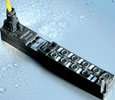
SMS Demag has set standards in the introduction of innovative technologies for breakout prediction systems in continuous casting applications. Temperature measurement via thermocouples has proven to be the most suitable and reliable technique. The Fieldbus Box modules in protection class IP 67 offer the basis for safe local signal acquisition.
SMS Demag AG, headquartered in Germany, is a leading manufacturer of metallurgical plant and rolling mill equipment. The company has been active for nearly 200 years and develops, constructs and builds machines and plant for the steel, aluminium and copper industries around the world. The range includes both system and automation solutions for the complete process chain, from iron making via steel plant, continuous casting, rolling mill and pipe technology to finishing lines for hot and cold rolled strip.
Continuous casting plants are used for the production of steel slabs that can be further processed into flat steel bars, so-called coils or wires, for example in rolling mills. The steel is liquefied in a blast furnace and poured into a mould. The mould is the first part of a continuous casting plant and is decisive for the shape and first solidification of the subsequent product. The profile is almost rectangular; the length in the direction of production is approximately 1 m. On the inside, the mould is clad with copper plates that are equipped with thermocouple sensors for measuring the temperature.
During the start of casting, the mould is closed at the lower end with a dummy bar head, so that a stable skin can form in front of the plug and at the sides. Once this has solidified, the plug is removed and the slab is turned horizontally via appropriate rollers. It is then cut and further processed or transported to a warehouse.
During production, a quantity of steel that matches the quantity removed is continuously poured into the mould. The flow rate must be adjusted in such a way that the bar can form a firm skin in the mould. Notwithstanding the addition of casting flux as a lubricant and the vertical oscillation of the mould there is a risk of the skin sticking to the copper plates and tearing.
Approximately 80% of all breakouts are caused in this way. In order to prevent this, as many temperatures as possible are recorded and evaluated via gradient analysis. If irregularities are detected sufficiently early, whilst the affected part of the slab is still in the mould, they can be healed by reducing the flow rate.
Practical, cost-effective and flexible solution
The basis for successful early breakout detection is reliable logging of the up to 100 thermocouple sensors that are located in several rows on the copper plates of the mould. Until recently the usual method of recording the thermocouple signals was via multifunction couplers. A single coupler was used to record approximately 25 thermocouples and four such couplers were used in a mould.
In the new systems, to counter the adverse effects of the extremely high moisture levels (up to 99% humidity adjacent to the mould) caused by large quantities of condensation water, Fieldbus Box modules, designed with protection class IP 67 were selected to interface to the temperature and humidity sensors. At the same time, SMS Demag implemented a special protective housing directly at the mould, which is surrounded by water for cooling and protects the Fieldbus Box modules from the aggressive hydrofluoric acid.

The multicore master cables have been replaced with a hybrid cable for bus and power supply. Two special plug connectors that were specially developed for the harsh ambient conditions supersede the fault-prone and expensive multifunction coupler.
Comprehensive diagnostics
The Fieldbus Box modules for recording the thermocouple signals each provide connection options for up to four sensors. Each channel can be monitored individually for measuring range violations (broken wire or short-circuit). These diagnostic functions can be used both during production and offline in the workshop.

SMS Demag developed a diagnostics interface that accesses the variables from the TwinCAT PLC via standard ActiveX Control interfaces and - after appropriate processing - displays them as process data (temperature) or diagnostic information (Profibus diagnostics, sensor diagnostics).
For offline testing, a system was developed as standard workshop equipment, which also consists of a TwinCAT computer with fieldbus interface and appropriate diagnostic software. It can be used to check all sensors of the dismantled mould. In the event of a thermocouple being faulty, the sensor plug simply has to be disconnected, and the thermocouple removed and replaced with a new one. The same applies for a faulty fieldbus module.
System topology and key data of breakout prediction systems
Fieldbus technology:
* Profibus Fieldbus Box modules with IP-Link extension modules (extremely EMC-safe through fibre optic connection of the extension modules).
* Protection class IP 67.
* Extremely compact design.
* Wiring of the sensors via pre-assembled cable sets.
* Robust special plug connectors for Profibus hybrid line (fieldbus + supply voltage).
Real-time computer as data concentrator and evaluation system
* Industrial PC Pentium III, 850 MHz, 256 MB RAM, Profibus interface.
* Realtime extension for Windows NT/2000/XP, 1 ms tic time, jitter ±15 μs.
* Programming in IEC 61131-3.
* Realtime router with ADS system interface.
* Standard ActiveX interface for visualisation, diagnostics and database connection, techniques for accessing process and diagnostic data.
* TCP/IP interface for remote access (network, remote service).
* Online visualisation, online diagnostics.
* Offline diagnostics for thermocouples and fieldbus modules (workshop system).
* Realtime database for trend analysis and process modelling.
| Tel: | +27 11 795 2898 |
| Email: | [email protected] |
| www: | www.beckhoff.com |
| Articles: | More information and articles about Beckhoff Automation |

© Technews Publishing (Pty) Ltd | All Rights Reserved